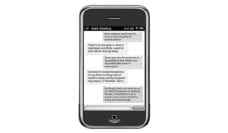Cigarette smoking typically begins in adolescence. The younger the age of initiation, the greater the risk of daily smoking, heavy cigarette consumption, nicotine dependence and difficulty quitting. Pediatricians and family practitioners are important sources of preventive counseling, but the lack of a screening tool to rapidly identify which adolescents need tobacco counseling is a major barrier in busy clinical practices.
My colleagues and I, at the Research Centre of the University of Montreal Hospital Centre in Montreal designed a new tool that quickly and accurately identifies adolescents at risk of starting to smoke in the next year. Our goal is to streamline counseling referrals for those who most need it.
We used data from the Nicotine Dependence in Teens (NDIT) study, which investigates the natural course of cigarette smoking in youth. The NDIT cohort includes 1,294 students initially recruited in 1999 at age 12-13 (grade 7) in ten Montreal-area high schools. Students completed in-class questionnaires every three months during the 10-month school year, from grade 7 to 11 (1999-2005), for a total of 20 cycles. In addition to information on cigarette smoking, they provided data on demographic characteristics, academic performance, smoking habits of family and peers, physical and mental health, weight, nicotine dependence, substance use, other lifestyle-related variables, and school and neighborhood smoking context.
Using state-of-the art artificial intelligence methods to select from among 58 known predictors of smoking initiation, we identified variables for inclusion in the screening tool.
A total of 370 adolescents began smoking during high school. Using state-of-the art artificial intelligence methods to select from among 58 known predictors of smoking initiation, we identified variables for inclusion in the screening tool. Adolescents need to respond to 12 questions including their age and alcohol consumption in order for us to be able to predict their risk of initiating smoking in the next year. The questionnaire includes questions on tobacco, such as whether the teen feels the need for a cigarette, whether they find it difficult not to smoke when others are smoking, and whether they have friends who smoke. The questionnaire contains two questions on self-esteem, one question on feeling hopeless about the future, and four stress questions focused on loneliness, weight, health problems, and relationships with siblings.
Each answer corresponds to a certain number of points which are summed to create a risk prediction for smoking initiation. Items associated with a reduced risk of smoking initiation were assigned negative points. Items associated with an increased risk of initiation were assigned positive points.
For example, the risk of initiation decreases with older age, worry about loneliness or health, and having high self-esteem. Consuming alcohol, worry about weight, and having friends who smoke increases the risk. We recommend that any young person with a positive score needs tobacco counseling. Since most variables included in this tool represent issues that can be addressed in preventive care, results can also guide physicians in how to counsel the youth identified as at-risk of becoming smokers.
A version of the tool is available online. This new screening tool shows good predictive properties, and takes only a minute to complete. Teens can easily do so while waiting to see their physician.
Feature image: imantsu/iStock














